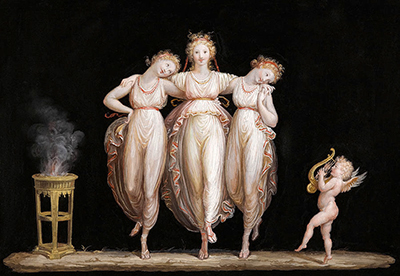There are several tempera on paper artworks by Antonio Canova which feature the Three Graces - a theme which appears within one of his most famous sculptures as well. Relatively little is known about the painted versions featured here, but they still add an interesting alternative to his work in stone.
This small body of work features dancing women dressed in beautiful dresses, with accompanying cupids and in one case, Mars. Mythology drove much of the artist's work, with Roman and Greek ancient tales giving him a base from which to produce some stunning sculptures and paintings. Whichever he was working on, he would start with drawing first in order to flesh out the main parts of the composition before then going into more detail once he started applying tempera or forming a portrait in marble. It is surprising in a way that Canova was still using tempera, many centuries after these techniques had lost favour in Italy. It was the influence of North Europeans who encouraged Italians to use oils instead and eventually this became their own preferred method in most cases. Perhaps Canova was short on resources at the time, and we do know that sculptures were not always popular as various stones could become hard to source.
The paintings towards the end of the 18th century by Antonio Canova would be amongst his final contributions within this medium. He started using tempera seriously in around the early 1780s, nearly two decades before these items here were completed. Canova would return to painting as a side interest whenever the feeling took him, but also sometimes when the necessary stone for his sculptures was in short supply. The conflicts between France and the kingdoms of Italy sometimes impacted his logistical management of his studio and left him short of some necessary resources, forcing him to reduce sculptural output from time to time. He actually took a positive approach to this situation, though, and saw it as an opportunity to work on his skills in other mediums and take a break from his normal discipline, in which he would have normally devoted a large amount of mental energy and physical work.
Canova would become highly regarded for his subtle but innovative sculptures which pushed things onwards from the earlier Baroque era. He married ancient methods with new ideas and academics greatily appreciated the approach that he took. This reputation helped him to obtain some highly significant commissions and he was one of the first choices for patrons during the late 18th and early 19th century. It will be after this that Italian art became slightly less successful as other nations took over, particularly France throughout the rest of the 19th century and beyond. Bernini was another key sculptor worthy of note, producing the likes of Ecstasy of Saint Teresa from a highly productive and impressive career in which he also became involved in architectural features too.




